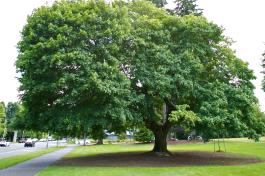Ginkgo
Ginkgo biloba
Learn about the ginkgo including when and why it was planted, how to identify it, and where to find it on campus.

Tree Facts
Traits
- Leaves have an unusual, two-part shape that resemble a fan
- Leaves turn a striking yellow in autumn
- Female trees produce oval fruit that is between 3/4 to 1 and 1/4 inches long, that turns orange when ripe
- No known serious susceptibilities
Native Range
- China
Story of the Tree
This tree is one of the oldest living tree species in the world. It's the sole survivor of an ancient group of trees that date back to before dinosaurs roamed the Earth, between 245 and 66 million years ago. It's so ancient, the species is known as a living fossil.
Millions of years ago, both ginkgo and dawn redwood grew in Washington. However, they became rarer as continental drift, ice ages, and volcanos changed the region over time.
This tree grows slowly but lives for hundreds of years and becomes huge.
A second ginkgo – a female – is on the East Campus, west of the Employment Security Building. Female specimens bear fruits consisting of an edible nut surrounded by a soft, orange skin.






